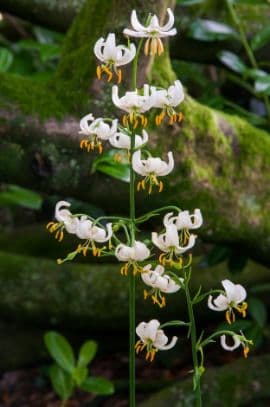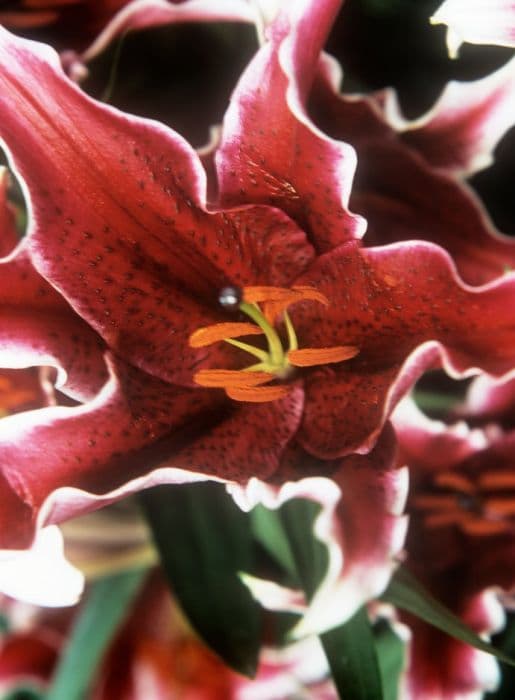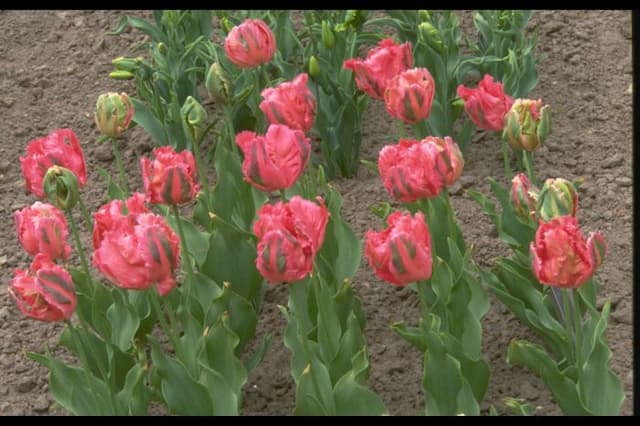Apricot Parrot Tulip Tulipa 'Apricot Parrot' (10)

ABOUT
The Tulipa 'Apricot Parrot', also commonly known as the Apricot Parrot Tulip, is a captivating garden plant known for its unique and intricately shaped flowers. The blooms of this tulip variety are characterized by their ruffled and fringed petals, which lend a sense of depth and extravagance. The flower's color palette is a delicate interplay of warm shades; it primarily exhibits a soft apricot hue, which can range from a pale, almost creamy tone to a deeper, sun-kissed apricot shade. The flower's color may be further accented with subtle brush strokes of green, yellow, or pink, which can create a beautiful gradient effect across the petals. The petals of the Apricot Parrot Tulip are distinct in their parrot-like appearance, with feather-like edges that create a dramatic presentation. The bloom is full and lush, with layers of petals that seem to twist and undulate, giving the flower a sense of movement and a tousled elegance. The overall appearance of the flower is one of intricate beauty, with each individual petal contributing to the flower's ornate and whimsical aesthetic. The foliage of the Apricot Parrot Tulip is equally attractive, typically presenting as lance-shaped leaves that are deep green, providing a perfect backdrop for the elaborate flowers. The leaves are smooth, with a waxy texture, and they may have a slight sheen that catches the light, further highlighting the stunning blossoms they cradle. The plant's structure is designed to showcase its flowers to their best advantage, ensuring that the blooms become the focal point in any garden setting where they are planted.
About this plant
 Names
NamesFamily
Liliaceae
Synonyms
Apricot Parrot Tulip
Common names
Tulipa 'Apricot Parrot'.
 Toxicity
ToxicityTo humans
The Apricot Parrot Tulip is generally considered to have a low level of toxicity to humans. If ingested, parts of the tulip, particularly the bulb, can cause symptoms such as nausea, vomiting, diarrhea, and dizziness. Contact with the skin can sometimes lead to irritation or an allergic reaction. In most cases, the consequences are not severe, but it is advisable to seek medical attention if symptoms persist or if large quantities of the plant have been ingested.
To pets
The Apricot Parrot Tulip is toxic to cats and dogs. If a pet ingests any part of the tulip, especially the bulb, it can lead to symptoms such as gastrointestinal upset, which might manifest as vomiting, diarrhea, drooling, and a loss of appetite. In some cases, more serious symptoms like depression, an increase in heart rate, or difficulty breathing may occur. If you suspect your pet has ingested tulip parts, seek veterinary care promptly.
 Characteristics
CharacteristicsLife cycle
Perennials
Foliage type
Deciduous
Color of leaves
Green
Flower color
Apricot
Height
1-2 feet (30-60 cm)
Spread
0-1 feet (0-30 cm)
Plant type
Bulb
Hardiness zones
3-8
Native area
Central Asia
Benefits
 General Benefits
General Benefits- Visual Appeal: The Apricot Parrot tulip has unique and strikingly beautiful apricot-colored petals that add a vibrant splash of color to any garden landscape.
- Garden Design Versatility: Its distinctive parrot-like petal shapes and color blend well with various other plants, allowing for creative and diverse garden designs.
- Attracts Pollinators: The bright colors and fragrant blooms of the Apricot Parrot tulip can attract bees and butterflies, aiding pollination in the garden.
- Spring Bloom: As a spring-flowering bulb, it provides early-season blooms that can be one of the first sources of nectar for pollinators after winter.
- Breeding Potential: Enthusiasts who enjoy bulb breeding can use the Apricot Parrot tulip for hybridizing to create new and interesting varieties.
- Cut Flower Use: Apricot Parrot tulips are excellent for cut flower arrangements due to their unique shape and color, often lasting well in a vase.
- Seasonal Interest: Planting these tulips provides a specific seasonal interest, celebrating the arrival of spring with their timely blossoming.
- Container Gardening: They are suitable for container planting, making them a good option for those with limited garden space or urban gardeners.
- Low Maintenance: Once planted, tulips require minimal maintenance, making them a suitable choice for both novice and experienced gardeners.
- Gift Potential: Apricot Parrot tulips, with their attractiveness, can be given as gifts in the form of bulbs or as part of a floral arrangement.
 Medical Properties
Medical PropertiesThis plant is not used for medical purposes.
 Air-purifying Qualities
Air-purifying QualitiesThis plant is not specifically known for air purifying qualities.
 Other Uses
Other Uses- The petals of the Apricot Parrot Tulip can be used to make a natural dye for fabrics, providing a soft apricot to yellowish hue.
- These tulips can be used in photography projects as a subject to explore concepts of texture and form due to their ruffled petals.
- Apricot Parrot Tulip petals can serve as a colorful garnish for salads and desserts, adding an elegant touch to culinary presentations.
- The flower blooms can be used in crafting, for instance, in making handmade paper or pressed flower arrangements.
- When dried, the petals can be incorporated into potpourri mixes to add color and subtle shape variations.
- Tulip petals, including those from the Apricot Parrot, can be used as a natural confetti at celebrations, being biodegradable and eco-friendly.
- Students and educators can use the plant in biology classes to study tulip anatomy and pollination strategies.
- The Apricot Parrot Tulip can be used in float designs due to their vibrant color and unique shape during festive parades.
- These tulips can be planted as part of a butterfly garden to help attract and support various species of butterflies.
- Their strong stems and distinctive flowers make them suitable for use in wind chimes or garden mobiles when dried and preserved.
Interesting Facts
 Feng Shui
Feng ShuiThe Tulip is not used in Feng Shui practice.
 Zodiac Sign Compitability
Zodiac Sign CompitabilityThe Tulip is not used in astrology practice.
 Plant Symbolism
Plant Symbolism- Love: Traditionally, tulips are symbols of perfect love, with Apricot Parrot tulips adding a nuance of tender affection and warmth due to their soft, warm color.
- Royalty: The unique appearance of Apricot Parrot tulips, with their lush, full petals, imparts a sense of nobility and regal presence.
- Prosperity: Tulips, in general, can symbolize abundance and indulgence, hinting that the luxurious look of the Apricot Parrot variety might align with wealth.
- Elegance: The sophisticated form and color of Apricot Parrot tulips suggest gracefulness and refined taste.
- Rebirth: As spring flowers, tulips embody the idea of new beginnings and rejuvenation, and the Apricot Parrot, blooming in spring, is no exception.
 Water
WaterApricot Parrot tulips should be watered deeply once a week if there hasn't been significant rainfall, ensuring the soil is moist but not waterlogged. In the spring, when they are actively growing and blooming, offer about 1 inch of water each week. After they finish blooming and their foliage starts to yellow, gradually reduce watering. During this dormancy period, excessive water can harm the bulbs. If planted in containers, check the top inch of soil; if dry, water until moisture seeps out of the drainage holes, which might be approximately 32 onzes for a standard-sized pot.
 Light
LightApricot Parrot tulips thrive best in full sun conditions, meaning they should receive at least 6 to 8 hours of direct sunlight daily. The ideal spot for these tulips will be an area that is free from shade for the majority of the day, without any tall trees or structures casting shadows over them. If full sun isn't possible, they can still perform well with a bit of light afternoon shade.
 Temperature
TemperatureThe Apricot Parrot tulip prefers a cooler climate with temperatures ranging between 35 to 70 degrees Fahrenheit. They can survive winter chills down to about 14 degrees Fahrenheit, but extreme heat over 70 degrees can be detrimental. The ideal temperature range for tulip growth and flowering is between 50 to 65 degrees Fahrenheit. These bulbs require a cold dormant period to thrive and bloom.
 Pruning
PruningPruning Apricot Parrot tulips is mainly about deadheading spent flowers to encourage the plant to put energy into the bulb for next year's growth rather than seed production. Prune the flower stalks once the blossoms fade but leave the foliage in place. The leaves should be allowed to die back naturally as they feed the bulb for the next season. Once the leaves have yellowed and withered, usually by late spring or early summer, they can be pruned away.
 Cleaning
CleaningNot needed
 Soil
SoilThe best soil mix for the Apricot Parrot Tulip should be well-draining, fertile, and slightly acidic to neutral in pH, approximately 6.0 to 7.0. A mix of loamy soil with added sand and organic matter like compost will provide the necessary nutrients and structure.
 Repotting
RepottingApricot Parrot Tulips are typically grown from bulbs that do not require repotting. Instead, bulbs should be planted in the ground or containers annually in the fall before the ground freezes.
 Humidity & Misting
Humidity & MistingApricot Parrot Tulips prefer outdoor conditions where humidity is naturally regulated; they do not require specific humidity levels when grown in their appropriate hardiness zones.
 Suitable locations
Suitable locationsIndoor
Plant in well-draining soil with ample light indoors.
Outdoor
Plant bulbs in fall; full sun to partial shade, well-draining soil.
Hardiness zone
3-8 USDA
 Life cycle
Life cycleThe Apricot Parrot Tulip begins its life cycle as a bulb planted in the fall before the first frost. It remains dormant underground during the winter, where it conserves energy for the growing season. In early to mid-spring, the bulb awakens and sends up leaves and a stem, followed by the distinctive parrot-shaped, apricot-hued flowers that give the variety its name. After blooming, which lasts for a few weeks, the plant sets seed and then slowly begins to wither as the foliage dies back, channeling energy back into the bulb. The bulb's life cycle enters a period of dormancy again through the summer until the following fall. Over years, the bulb might produce offsets (small bulbs), which can be separated and planted to propagate new plants.
 Propogation
PropogationPropogation time
Spring
The most popular method of propagation for the Tulipa 'Apricot Parrot', commonly known as the Apricot Parrot Tulip, is by dividing and replanting the bulb offsets. Typically, this process is best done in the fall when the foliage has died back and the plant is dormant. After digging up the bulbs, growers separate the small offsets from the main bulb, which are essentially baby bulbs that have developed at the base. These offsets can be replanted immediately at a depth of about 6 to 8 inches (15 to 20 centimeters) to encourage rooting and development in their new location. It's important to provide well-drained soil and to plant the bulbs in an area that receives full to partial sunlight. By the following spring, these offsets will have developed enough to produce their own blooms, thus carrying on the lineage of the unique and beautiful Apricot Parrot Tulip.




![Lily [Roselily Chelsea]](/_next/image?url=https%3A%2F%2Fplants-admin.emdemapps.com%2Fimages%2Fplants%2F%2Fimages%2F604b584f6f830.png&w=640&q=75)




